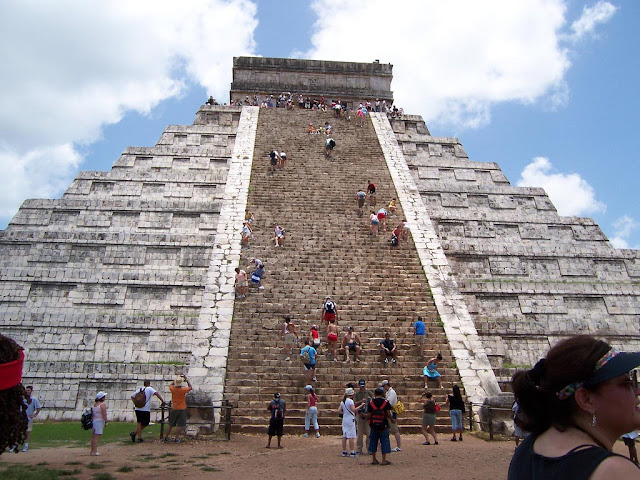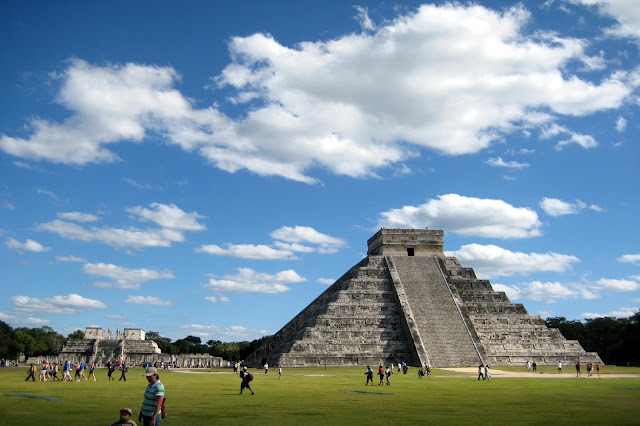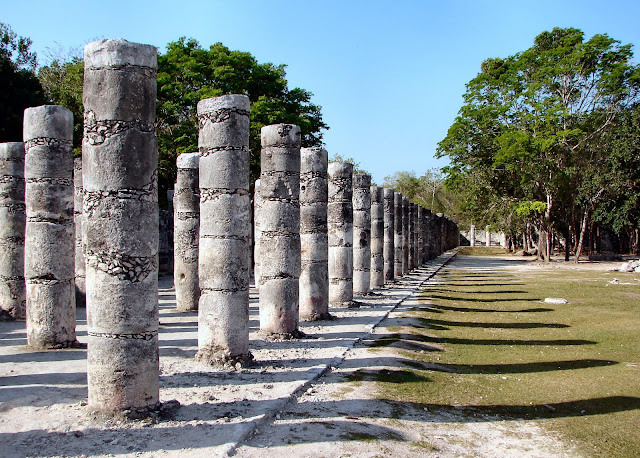This sacred site was one of the greatest Mayan centres of the Yucatán peninsula. Throughout its nearly 1,000-year history, different peoples have left their mark on the city. The Maya and Toltec vision of the world and the universe is revealed in their stone monuments and artistic works. The fusion of Mayan construction techniques with new elements from central Mexico make Chichen-Itza one of the most important examples of the Mayan-Toltec civilization in Yucatán. Several buildings have survived, such as the Warriors’ Temple, El Castillo and the circular observatory known as El Caracol.
 |
| Chichen Itza |
Chichen Itza is the most important archaeological vestige of the Maya-Toltec civilization in Yucatán (10th-15th centuries). Its monuments, particularly in the northern group which includes the Great Ball Court, Temple of Kukulkan and Temple of the Warriors, are among the undisputed masterpieces of Mesoamerican architecture because of the beauty of their proportions, the refinement of their construction and the splendour of their sculpted decorations. These monuments exerted an influence throughout the entire Yucatán cultural zone from the 10th to the 15th centuries.
Located midway between Mérida and Cancún, Chichen Itza is the northernmost of the major archaeological sites in Yucatán. Covering more than 300 ha, it is also one of the largest and richest in monuments. Above all, it is one of the most significant in historical terms because it illustrates two major periods in pre-Hispanic civilizations in the Mesoamerican zone.
The town was established close to two natural cavities (cenotes or chenes), which facilitated tapping the underground water area of the cenote of Xtoloc during the Classic period. The dates for this settlement vary according to subsequent local accounts: one manuscript gives 415-35, while others say 455. The town that grew up around the sector known as Chichen Viejo already boasted important monuments of great interest: the Building of the Nuns, church, Akab Dzib, Chichan Chob, Temple of the Panels and Temple of the Stag. They were constructed between the 6th and 10th centuries in the characteristic Mayan style then popular both in the northern and southern areas of the Puuc hills.
The second settlement of Chichen Itza, and the most important for historians, corresponded to the migration of Toltec warriors from the Mexican plateau towards the south during the 10th century. According to the most common version, the King of Tula, Ce Acatl Topiltzin Quetzalcoatl, or Kukulkan as the Mayans translated the name, reportedly took the city between 967 and 987 after wandering for many years. What is known for certain is that the Toltec invaders subjugated the local population with a ferocity which even five centuries later the chronicles of the 'sacred books' of the Mayans spoke of. The Toltecs imposed the ritual of human sacrifice which until then was rarely, if at all, practised in the region.
Following the conquest of Yucatán a new style blending the Mayan and Toltec traditions developed, symbolizing the phenomenon of acculturation. Chichen Itza is a clear illustration of this fusion. Specific examples are, in the group of buildings to the south, the Caracol, a circular stellar observatory whose spiral staircase accounts for its name, and, to the north, the Pyramid of Quetzalcoatl, El Castillo. Surrounding El Castillo are terraces where the major monumental complexes were built: on the north-west are the Great Ball Court, Tzompantli or the Skull Wall, the temple known as the Jaguar Temple, and the House of Eagles; on the north-east are the Temple of the Warriors, Group of the Thousand Columns, market and ball courts; on the south-west is the Tomb of the High Priest.
This new architecture, known today as Maya-Yucatec, took from the old local structures the art of stereotomy used on walls and vaults while incorporating certain Toltec elements in the decorations. Besides all the battle scenes, which are depicted in luxurious detail, the most obvious of the influences from central Mexico are the likenesses of the plumed serpent Quetzalcoatl, present on columns and substructures where enormous heads of reptiles create a vigorous decorative motif. Other examples of the Mexican influence are the famous statues of the rain god Chac-Mool, executed in a typical half-reclining pose.
The history of Chichen Itza from the end of the 10th to the 15th centuries is complex. The monopolistic authority of military leaders seems to have been mitigated after the city joined the Mayapán League, which included Uxmal. After the 13th century no major monuments seem to have been constructed at Chichen Itza and the city rapidly declined after the fall of Mayapán. In 1556 Bishop Diego de Landa visited the practically abandoned ruins and recorded the legends pertaining to the various monuments. The ruins were not excavated until 1841.
Text source:- Wikipedia. Images are copyrighted by their owners. Found any copyright issue, contact the administrator immediately. Report it now!
You have read this article Heritage Cultural /
Mexico /
North America /
North America Heritage /
Wonders
with the title Chichen Itza. You can bookmark this page URL http://tiffanyeatworld.blogspot.com/2011/07/chichen-itza.html. Thanks!

















